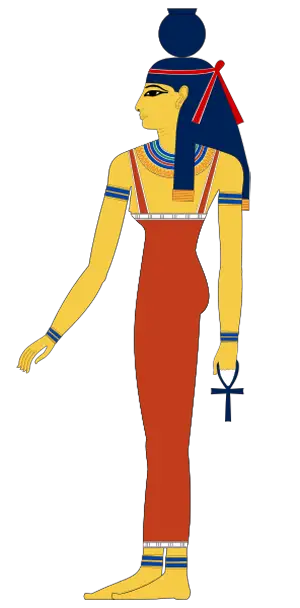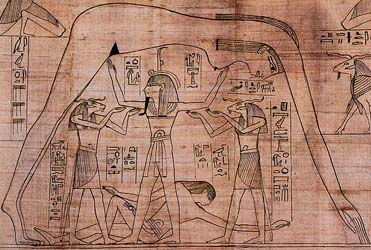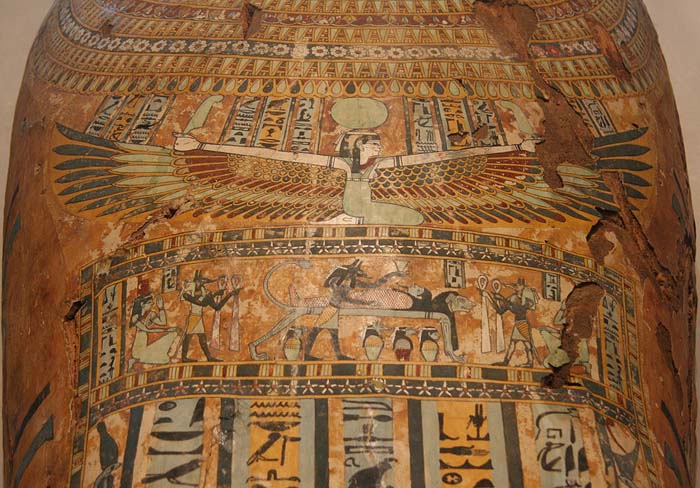Mother Goddess

© A. Parrot – The Goddess Nut
Egyptologists believe that Nut was a sky goddess originally worshiped by the early tribes of the Nile Valley area. In Lower Egypt, the Milky Way was viewed as the celestial image of Nut. She was adopted into the family tree of the Egyptian gods as the daughter of Shu, the god of the air, and Tefnut, the goddess of moisture. She became the sky, while her brother Geb became the god of earth.
In the creation story, Egyptians viewed Nut and Geb as passionate lovers. At one time, they embraced so tightly that nothing could come between them. Shu became jealous and separated the two. Shu became the air that moves between the sky and the earth. This story explained the separation of the sky from the earth. The mythological separation came too late, and Nut was pregnant. She gave birth to all of the stars and planets. Her children would always stay close to her as she was the sky.
Despite a curse from her father which left her barren, Nut seduced the god Thoth. She gave birth to five more children on the epagomenal days of the Egyptian calendar. Her children, Osiris, Haroeris, Set, Isis and Nephthys, became five important gods in Egypt.
Day and Night
Two different Egyptian myths place Nut as having vital powers in the sequence of day and night. In reference to Nut as a lover, Egyptians believed that Nut and Geb separated during the day. In the evening, Nut would come down to Earth to meet with Geb. Her absence from the sky resulted in darkness.
The other myth refers to Nut as the mother of Ra. Ra uses her body as a pathway for the sun in the sky. Every night, Nut swallows Ra. She gives birth to Ra every morning to start the day anew. The Pyramid Texts of the pharaoh Pepi tell this story and reveals Nut as the “Great Goddess of the Sky”. In this form, she is the mother of all life and the one who receives all spirits.
Represented in Many Ways
Nut’s appearance varied in many ways throughout Egypt. Some pictures depict her sitting with a water pot on her head. The hieroglyph for her name is also a water pot. Egyptologists believe that the water pot represented a womb.

Nut stretched over Shu and Geb
One of the most common forms of Nut features her as an arch stretching over the earth. This version of Nut is found in the tomb of Ramses VI in the Valley of the Kings. Her body forms a semi-circle with only her fingers and toes touching the ground. In some versions, her father, Shu, holds her up. Her husband, Geb, reclines underneath her and represents the hills and valleys of the earth. Golden stars cover her body to represent the souls of her children.
Nut is often featured inside of coffin lids as a symbol of the sky over the deceased soul in the afterlife. In this form, she was known as the goddess of death. Almost every sarcophagus located at the Cairo Museum features the figure or face of Nut inside the lid. Some coffins feature her as having protective wings, while others symbolize her as a ladder. Her role in the afterlife tied closely with the view of her as the ultimate mother. The journey of death would bring the dead back to the arms of the goddess-mother Nut, much like night would bring Ra back to her.

Goddess Nut with her wings stretched over a coffin
Other less common forms feature her as a giant sow with many suckling piglets. Egyptians believed her piglets to be the nighttime stars, which Nut would swallow every morning. In other representations, she a cow goddess with eyes representing the sun and the moon.
Worship of Nut
Although Nut’s chief cult center was located at Heliopolis, Egyptians at Memphis worshiped Nut as a healing goddess at a shrine called the House of Nut. A sycamore tree symbolized her home, but she was later replaced in the tree by the goddess Hathor. Despite being a central part of Egyptian worship, she had no known temples built exclusively for her.
Nut would also be associated with Hathor at Dendera. Texts at the Temple of the Birth of Isis reveal how Isis was born at Dendera under the watchful eye of Hathor. Tourists still view inscriptions and reliefs of Nut at Dendera which revealing her both astronomical importance and her religious importance as the mother of all creation.









































